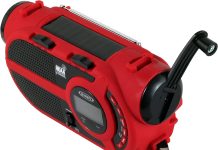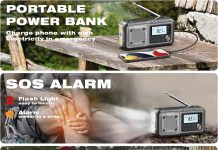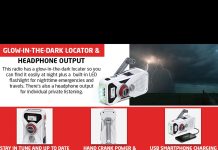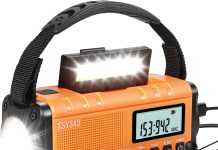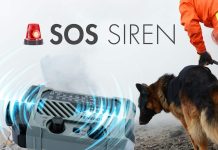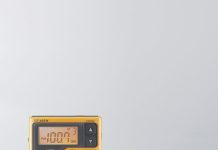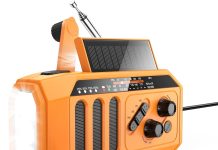In this article, we explore the effectiveness of emergency radios during power outages. Have you ever wondered just how well these radios function when the lights go out? We aim to shed light on this topic and provide valuable insights into the reliability and usefulness of emergency radios in such critical situations. So, let’s tune in and find out if these radios truly have our backs when the power goes out!
Review contents
Types of emergency radios
Emergency radios are essential tools that can provide vital information and communication during power outages or other emergency situations. There are several types of emergency radios available in the market, each with its own unique features and functionality. In this article, we will explore the different types of emergency radios, including battery-powered radios, hand-crank radios, solar-powered radios, and wind-up radios, examining their working mechanisms, benefits, drawbacks, and overall effectiveness.
Battery-powered radios
Battery-powered radios are the most common type of emergency radios. They rely on a set of batteries to power their operation, making them portable and easy to use. These radios typically come with built-in speakers and are equipped with various features and functionalities to enhance their performance during emergencies.
Features and functionality
Battery-powered radios often come with a wide range of features and functionalities that can greatly aid in emergency situations. These features may include multiple broadcast bands, such as AM/FM and NOAA weather channels, allowing users to tune in to different types of broadcasts. Some radios also offer additional features like LED flashlights, built-in sirens, and even USB charging ports for other devices.
Battery life
One crucial aspect to consider when choosing a battery-powered radio is its battery life. During power outages, it is imperative to have a radio that can operate for extended periods without the need for frequent battery changes. Opting for radios with long battery life or those that offer the option to use rechargeable batteries can ensure uninterrupted operation when power is unavailable.
Ease of use
In emergency situations, ease of use becomes paramount. Battery-powered radios are generally designed with simplicity in mind, making them user-friendly even in high-stress situations. Intuitive buttons, clear displays, and straightforward tuning mechanisms enable users to quickly tune in to emergency broadcasts and stay informed.
Reliability
Reliability is another essential factor to consider when choosing a battery-powered radio. These radios should be durable and capable of withstanding harsh conditions. Ideally, they should also have a good reception range and signal strength to ensure consistent reception, even in remote or less populated areas.
Hand-crank radios
Hand-crank radios, also known as crank-powered radios, offer a unique way of generating power. These radios are equipped with a hand-crank mechanism that allows users to generate power by manually rotating a handle. This energy is then stored in the radio’s internal battery, providing a power source for operation.
Working mechanism
The working mechanism of hand-crank radios is straightforward and efficient. By cranking the handle for a few minutes, the radio’s internal battery is charged, enabling it to function without the need for external power sources. Some hand-crank radios may also come with additional charging capabilities, such as a built-in solar panel or a USB port, providing alternative methods to charge the battery.
Benefits of hand-crank radios
Hand-crank radios offer several benefits that make them a popular choice for emergency preparedness. One of the significant advantages is their ability to generate power without relying on external batteries or power outlets. This makes them highly reliable during prolonged power outages when conventional batteries may become depleted. Hand-crank radios are also portable and lightweight, making them easy to carry during evacuations or in other emergency situations.
Drawbacks of hand-crank radios
While hand-crank radios have their advantages, they do come with a few drawbacks. One of the main challenges is the physical effort required to hand-crank them to generate power. Depending on the radio’s design and battery capacity, users may need to crank the handle for extended periods to ensure sufficient power for prolonged use. Additionally, some hand-crank radios may have limited battery storage capacity, resulting in shorter operating times compared to battery-powered or solar-powered radios.
Effectiveness during power outages
Hand-crank radios excel during power outages since they do not rely on external power sources. As long as the user is willing to periodically crank the handle to generate power, these radios can provide consistent access to emergency broadcasts. However, users should keep in mind that prolonged use of hand-crank radios may result in fatigue, which could impact their ability to crank the handle continuously.
Solar-powered radios
Solar-powered radios utilize renewable solar energy to power their operation. These radios come equipped with built-in solar panels that convert sunlight into electrical energy, which is then stored in the radio’s internal battery for later use.
How solar-powered radios work
Solar-powered radios work by harnessing the power of the sun through their integrated solar panels. When exposed to sunlight, these panels generate electricity through a process called the photovoltaic effect. This electrical energy is then used to charge the radio’s internal battery, allowing it to function without the need for replaceable batteries or external power sources.
Advantages of solar-powered radios
Solar-powered radios offer several advantages that make them a reliable choice for emergency situations. The primary advantage is their ability to operate without the need for external batteries, reducing the reliance on disposable or rechargeable batteries. Solar power is also a renewable energy source, decreasing environmental impact. Additionally, solar-powered radios often come with long-lasting internal batteries, ensuring extended periods of operation even in low sunlight conditions.
Limitations of solar-powered radios
While solar-powered radios have their merits, they do have some limitations. The most significant limitation is their dependence on sunlight for charging. In cloudy or heavily shaded areas, solar panels may not receive enough sunlight to generate sufficient energy, limiting the radio’s charging capabilities. Moreover, during nighttime hours or in indoor environments, solar-powered radios may be unable to charge at all, requiring users to have alternative power sources available.
Reliability in power outage situations
Solar-powered radios can be highly reliable during power outage situations, provided there is sufficient sunlight available to keep them charged. By placing the solar panels in direct sunlight, users can ensure a continuous power supply for extended periods. However, it is crucial to have alternative charging methods or backup batteries available in case of prolonged cloudy weather or other conditions that restrict solar charging.
Wind-up radios
Wind-up radios, also known as crank-powered or hand-wind radios, are radio devices that can generate power through a wind-up mechanism. These radios utilize a hand crank or winding lever to rotate an internal generator, producing electrical energy that is stored in the radio’s built-in battery.
Working principle
Wind-up radios operate based on a simple yet effective working principle. By winding the crank or lever for a specified duration, users manually rotate the internal generator, which converts this mechanical energy into electrical energy. This electrical energy is then stored in the radio’s internal battery, allowing for continued operation without the need for replaceable batteries or external power sources.
Benefits of wind-up radios
Wind-up radios offer several benefits that make them a popular choice for emergency preparedness. One of the significant advantages is their ability to generate power through manual hand winding, eliminating the need for external batteries or power outlets. These radios also tend to have long-lasting internal batteries, enabling extended periods of operation. Additionally, wind-up radios are typically more durable and resilient, capable of withstanding harsh conditions.
Challenges faced by wind-up radios
While wind-up radios have their advantages, they do face certain challenges. One of the main challenges is the physical effort required to wind up the radio’s crank or lever manually. Depending on the radio’s design, users may need to wind the mechanism for an extended period to ensure sufficient power for prolonged use. Additionally, wind-up radios may have limited battery storage capacity, resulting in shorter operating times compared to battery-powered or solar-powered radios.
Performance during power outages
Wind-up radios are designed to perform reliably during power outages, as they do not rely on conventional power sources. With the ability to generate power through manual winding, these radios provide consistent access to emergency broadcasts and important information. However, similar to hand-crank radios, users should be mindful of the physical effort required to continuously wind the radio, as fatigue may impact the user’s ability to generate power for an extended duration.
Factors affecting the performance of emergency radios
Several factors can significantly affect the performance of emergency radios, regardless of their type. These factors should be considered when selecting an emergency radio to ensure optimal functionality and reliability.
Signal strength
The signal strength of an emergency radio plays a crucial role in determining the quality and clarity of received broadcasts. Radios with strong signal reception capabilities are more likely to provide clear and uninterrupted reception even in remote or low signal areas. When choosing an emergency radio, it is essential to consider its signal strength and reception range, especially if you are located in an area with weak signal coverage.
Interference
Interference from various sources, such as other electronic devices or physical obstacles, can impact the effectiveness of emergency radios. Strong electromagnetic fields or metal structures may disrupt radio signals, causing static or interrupted reception. To minimize interference, it is advisable to keep the radio away from other electronic devices that emit electromagnetic fields and to position it in areas with fewer physical obstructions.
Battery quality
The quality of the batteries used in an emergency radio can directly affect its performance and longevity. Opting for high-quality batteries or rechargeable batteries can ensure longer operating times and reduce the risk of sudden power drain during critical moments. Regularly checking and replacing batteries when needed is crucial to maintain the radio’s reliability.
Radio durability
Emergency radios need to be durable and capable of withstanding harsh conditions. They may be exposed to extreme temperatures, moisture, or physical impact during emergencies. Choosing radios that are built with durable materials, have water-resistant features, and meet industry standards for durability can ensure their long-term functionality and reliability.
User experience
The user experience, including ease of use and intuitive functionality, greatly impacts the overall effectiveness of emergency radios. During high-stress situations, radios that are simple to operate and have clear displays, labeled buttons, and user-friendly interfaces enable users to quickly access vital information. Ensuring that the emergency radio is user-friendly increases the likelihood of seamless operation when every second counts.
Availability of emergency radio broadcasts
Emergency radio broadcasts are an essential source of information during power outages and other emergency situations. They provide crucial updates, weather alerts, evacuation instructions, and other important information that can help individuals stay safe and make informed decisions. Emergency radio broadcasts are made available through various channels, ranging from local radio stations to national emergency radio networks.
Local radio stations
Local radio stations play a crucial role in disseminating emergency information to communities. During power outages, local radio stations often become a vital lifeline for residents by broadcasting updates and instructions from local authorities, emergency management agencies, and weather services. Users can tune in to their local radio stations using emergency radios to stay informed about the situation in their immediate vicinity.
National emergency radio networks
In addition to local radio stations, national emergency radio networks provide comprehensive coverage and information during emergencies. These networks, such as the NOAA Weather Radio in the United States, cater to a broader audience and offer continuous weather updates, emergency alerts, and important safety information. Emergency radios with NOAA weather channel capabilities allow users to access these networks and receive critical updates on a national scale.
Types of information provided
Emergency radio broadcasts offer a wide range of information to help individuals navigate through emergencies. This includes severe weather warnings, evacuation orders, road closures, shelter locations, emergency contact information, and updates from government agencies or relief organizations. By tuning in to emergency broadcasts, individuals can receive real-time information and make informed decisions for themselves and their families.
Importance of access to emergency broadcasts
Having access to emergency radio broadcasts is of utmost importance during power outages and other emergency situations. When traditional communication channels, such as cellular networks or internet services, are disrupted, emergency radios become invaluable sources of information and communication. These radios ensure that individuals stay connected, receive critical updates, and are aware of any potential dangers or changing circumstances.
Tips for maximizing the effectiveness of emergency radios
To make the most out of emergency radios, there are several tips and practices individuals can follow to ensure their effectiveness during power outages or other emergencies.
Ensure proper battery maintenance
Regularly check the batteries in the emergency radio and replace them when needed. Opting for high-quality batteries or rechargeable batteries can provide longer operating times and reduce the risk of sudden power drain during critical moments.
Stay tuned to reliable channels
Identify and stay tuned to reliable channels and stations that provide accurate and up-to-date information during emergencies. Ensure that the emergency radio is set to the appropriate frequencies or channels to receive the desired broadcasts.
Test the radio periodically
Periodically test the emergency radio to ensure its functionality and signal reception. This can be done by tuning in to different channels or frequencies and checking the clarity of the reception. Regular testing allows for the identification of any potential issues or limitations before an actual emergency occurs.
Have alternative power sources
In addition to emergency radios, consider having alternative power sources available, such as portable power banks or solar chargers. These can provide additional power to recharge the radio’s batteries, especially during extended power outages or situations with limited access to sunlight.
Keep spare batteries or a backup radio
In case of battery failure or a malfunctioning radio, it is advisable to keep spare batteries or a backup emergency radio on hand. This ensures that there is always a reliable source of information and communication available, even in challenging circumstances.
Comparing emergency radios to other communication methods
Emergency radios are just one option for communication during power outages or emergencies. It is essential to compare them with other widely used communication methods to determine their effectiveness and suitability for different situations.
Cellular phones
While cellular phones are commonly used for communication, they heavily rely on cellular network coverage and require electricity to charge. During power outages, cellular networks may become overloaded or unavailable, rendering them less reliable than emergency radios. However, smartphones can still be a useful tool for accessing emergency apps or internet-based information if the phone is adequately charged.
Landline telephones
Traditional landline telephones can be an effective means of communication during power outages, as they are often connected directly to the telephone exchange and operate independently of electric power. However, landline telephones are susceptible to damage or disruption caused by severe weather events, making them less reliable than emergency radios in certain circumstances.
Internet and Wi-Fi
Internet and Wi-Fi services heavily rely on electricity and may become unavailable during power outages. While they offer various communication options, such as messaging or VoIP services, their reliance on stable electrical power and network availability can limit their effectiveness during emergencies.
Two-way radios
Two-way radios, also known as walkie-talkies, are portable communication devices that allow for direct communication between two or more users. They can be a useful tool for coordination and communication within a close range. However, two-way radios generally have limited signal range and require all users to have their own radios, making them less practical for receiving emergency broadcasts or obtaining information from external sources.
Conclusion
Emergency radios serve as valuable tools during power outages and other emergencies, providing access to vital information, updates, and communication. Battery-powered radios offer convenience and various features, while hand-crank radios offer self-powered operation. Solar-powered radios harness renewable energy, and wind-up radios rely on manual effort for power generation. Factors such as signal strength, battery quality, and user experience impact the performance of emergency radios. Access to emergency radio broadcasts through local stations and national networks is crucial for staying informed and making informed decisions. By following tips for maximizing effectiveness and comparing emergency radios to other communication methods, individuals can choose the most suitable option for their emergency preparedness needs. With reliable emergency radios on hand, we can stay connected and informed, even in the most challenging circumstances.


